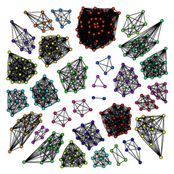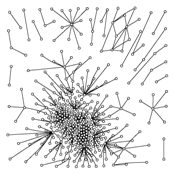|
|
Last Minute Info
- Hand-out material
A link for the factDesign.pdf vignette in the Limma lab, estrogen data, is obsolete. Instead, take a
look at the factDesign package.
- Access to wireless network. The room is covered by a
wireless network. You will need an eduroam
account from your home university. You should
consult your own institution for guides on how to
set up your computer with an eduroam account. You
may also take a look at our
local guide for the Department of Mathematical
Sciences, which in addition provides links to further
information.
If you don't have an eduroam account we have a guest account that you
will get upon arrival. There is a pdf guide (Danish)
on how to set up XP for using the guest account.
If everything else fail we should be able to connect at least some of
the computers with cables.
Time and Place
The course takes place from Monday, November 5 to Friday, November 9,
2007.
The lectures and exercises will take place at the
University of Copenhagen
Copenhagen Biocenter
Ole Maaløes Vej 5
DK-2200 Copenhagen Ø
Rooms 4-0-24/4-0-5/4-0-13
The course is organized with a mix of lectures and supervised computer
exercise session each day.
Course Description
| The course aims
to give Ph.D.-students in statistics as well as other Ph.D.-students a
good introduction to microarray data analysis using R and
Bioconductor. This is achieved by inviting some of the leading
researchers in statistical analysis of microarray data and developers
of R-packages to give the main lectures and combine this with hands-on
computer exercises. |
The following distinguished experts in the use of R and
Bioconductor for the analysis of microarray expression data have agreed to
present the five main morning lectures:
- Wolfgang Huber, Group Leader, EBI/EMBL Cambridge
- Gordon Smyth, Senior Research Scientist, WEHI Bioinformatics
- Vincent Carey, Associate Professor, Harvard Medical School
- Denise Scholtens, Assistant
Professor, Northwestern University Medical School
- Steffen Durinck, Postdoctoral Fellow, Lawrence Berkeley National Laboratory
The tentative list of topics that will be covered looks as follows:
|
The computer lap sessions will be supervised by
- Kasper Daniel-Hansen, Ph.D.-student, UC-Berkeley
- Niels Richard Hansen, Associate Professor, University of Copenhagen
- Monday 5/11. Introduction to microarray data and the biological questions,
data-formats and representations in R, S4-classes (Wolfgang Huber).
Introduction to microarrays:
- technologies, data formats, the data representation in Bioconductor,
preprocessing and normalisation, quality assessment
Introduction to R and Bioconductor
Simple differential expression
- Tuesday 6/11. Linear models and Limma (Gordon Smyth).
Morning Lectures
- Introduction, Background correction, Moderated t-tests, Linear models I
Morning Practical
- Weaver data, Estrogen data I
Afternoon lectures
- Linear models II, Moderated F-tests, Multiple testing, Gene set tests, Duplicate spots
Afternoon practical
- Estrogen data II, SAHA depsi data
- Wednesday 7/11. Machine Learning and microarray data analysis
(Vincent Carey).
Clustering and predictive modeling with high-throughput
biological experiments: Basic concepts and tools
- Motivating examples: Clustering and the yeast cell cycle;
Golub's paper; some aCGH data
- Clustering: definitions and algorithms; distances
- Predictive modeling: definitions and algorithms
Evaluation of methods and models. Simple and realistic
simulations; example of B. Frey's message-based clustering algorithm
(Science 2007). Michiels Lancet 2005. Molinaro, Simon et al.
Bioinformatics 2005. Scope and limits of cross-validation.
- Thursday 8/11. Graphs and dependence structures (Denise
Scholtens).
Graphs and Dependence
Graphs consisting of nodes and edges are commonly used structures to represent
high-throughput data in systems biology research. Often nodes are used to
represent genes and/or proteins and edges are used to represent relationships
among them. In this series of lectures and tutorials, we will learn about
object classes in R specifically designed for handling graph-type data, and
the collection of graph traversal algorithms and visualization capabilities
available in Bioconductor. We will study applications of graphs to microarray
and other high-throughput data, and will explore the benefits of placing
commonly performed microarray data analyses into a graph theoretic context.
- Friday 9/11. Querying external databases and metadata and
generating reports (Steffen Durinck).
Database mining with biomaRt
- The BioMart software suite, bioMart packages for R
- Automatic report generation using Sweave
Prerequisites
The participants are expected to have prior experience with R and statistics
in general, and an interest in the biological questions. The participants are
also expected to bring their own laptop for the exercises. We require that all
participants install the latest version of R (R-2.6.0, released October 3,
2007) and the latest version of Bioconductor (Bioc-2.1, scheduled to be
released October 5, 2007). The precise details for installation of R and
the required packages can be found here:
Installation instructions.
All participants will receive a certificate of participation.
ECTS-credits: 5
Program
| Date | Time |
Subject | Room |
|
Monday 5/11
|
8.45-9.00
|
Welcome and general information
|
4-0-24
|
|
|
9.00-10.45
|
Introduction to R and Bioconductor
|
4-0-24
|
|
|
11.00-12.30
|
Computer lab
|
4-0-5/4-0-13
|
|
|
13.15-15.00
|
Introduction to microarray normalisation and quality assessment
|
4-0-24
|
|
|
15.15-17.00
|
Computer lab
|
4-0-5/4-0-13
|
|
|
Tuesday 6/11
|
9.00-10.45
|
Limma
Lecture I
|
4-0-24
|
|
|
11.00-12.30
|
Computer lab
|
4-0-5/4-0-13
|
|
|
13.15-15.00
|
Limma
Lecture II
|
4-0-24
|
|
|
15.15-17.00
|
Computer lab
|
4-0-5/4-0-13
|
|
|
Wednesday 7/11
|
9.00-10.45
|
Clustering and predictive modeling with high-throughput
biological experiments: Basic concepts and tools
|
4-0-24
|
|
|
11.00-12.30
|
Computer lab:
Bioconductor facilities for creating and
interpreting cluster analyses.
|
4-0-5/4-0-13
|
|
|
13.15-14.30
|
Evaluation of methods and models.
|
4-0-24
|
|
|
14.45-16.30
|
Computer lab:
General exercises in machine learning with genomic data.
|
4-0-5/4-0-13
|
|
|
Thursday 8/11
|
9.00-10.45
|
Graphs and Dependence. Lecture I.
|
4-0-24
|
|
|
11.00-12.30
|
Computer lab.
|
4-0-5/4-0-13
|
|
|
13.15-14.30
|
Graphs and dependence. Lecture II.
|
4-0-24
|
|
|
14.45-16.30
|
Computer lab.
|
4-0-5/4-0-13
|
|
|
Friday 9/11
|
9.00-10.00
|
biomaRt
Lecture I
|
4-0-24
|
|
|
10.15-11.15
|
Computer lab
|
4-0-5/4-0-13
|
|
|
11.30-12.30
|
biomaRt
Lecture II
|
4-0-24
|
|
|
13.15-14.15
|
Computer Lab
|
4-0-5/4-0-13
|
|
|
14.30-15.30
|
Report generation
|
4-0-24
|
|
Registration and Payment
The registration has been closed
The registration fee is:
Danish Ph.D.-students: No registration fee.
Academia: DKK 1000,-
Non-academia: DKK 3000,-
which, among other things, will cover coffee/tea and snacks, lunch,
and hand-out material. Non-Ph.D.-students can apply for a reduced fee, see the registration form.
The deadline for payment is
October 17, 2007
The details for payment are as follows:
Payment to:
Department of Mathematical Sciences
University of Copenhagen
Universitetsparken 5
DK-2100 Copenhagen Ø
For Danish bank transfers:
Account number: 3001 4115212125
For international bank transfer:
SWIFT-code: DABADKKK
IBAN-code: DK41 3000 4115212125
Bank Address: Danske Bank A/S, Holmens Kanal 2, 1090 København K,
Denmark
IMPORTANT; the following reference and information must be
included for all transfers:
501000-12113-10
Bioconductor 2007
Your name
It is VERY IMPORTANT that you provide the number given above.
If the space is limited you should ONLY provide the reference number
501000 as a minimal reference. Do NOT try to write other parts of
the full reference number, if you can not write the full number.
Remember also that for INTERNATIONAL bank transfers you must pay ALL
the additional costs.
|
Miscellaneous
Material
Besides the hand-out material, we recommend the book:

Bioinformatics and Computational Biology Solutions Using R and
Bioconductor
Please find information on directions and accommodation on our website. Note that we have no possibility to give financial support for
participants.
|




